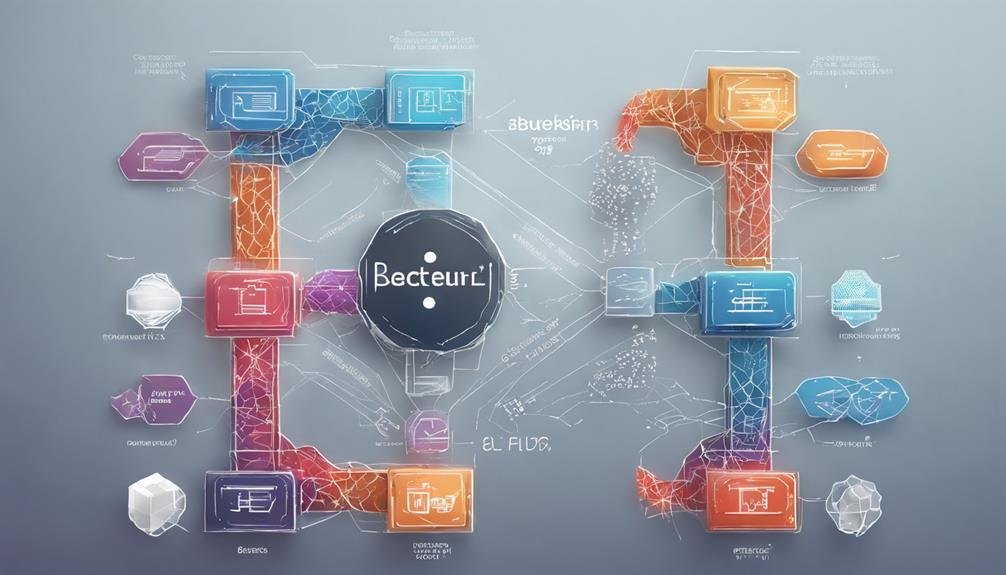Enhancing consensus mechanisms like Proof of Stake improves scalability. Chain forks increase efficiency through soft and hard forks. Sharding divides networks into parts for higher throughput. Optimize block validation processes for faster transactions. Leveraging parallel processing techniques boosts scalability. Implementing these fixes effectively addresses layer 1 blockchain limitations. The detailed research provided provides additional insights on blockchain enhancements.
Table of Contents
Brief Overview of Layer 1 Blockchain Limitations And Fixes
- Enhance consensus mechanisms like Proof of Stake for scalability.
- Implement chain forks for efficiency and security upgrades.
- Explore sharding solutions to boost transaction throughput.
- Optimize block validation processes for higher efficiency.
- Leverage parallel processing techniques to improve network capabilities.
Enhancing Consensus Mechanisms for Scalability
Improving consensus mechanisms is essential in addressing scalability issues and advancing the performance of Layer 1 blockchains. Upgrading traditional mechanisms like Proof of Work (PoW) to more efficient models such as Proof of Stake (PoS) can greatly enhance transaction speed and throughput. Algorand’s innovative Secure Proof of Stake algorithm, for instance, not only boosts scalability but also maintains high levels of security. Blockchain networks can achieve higher efficiency by optimizing consensus mechanisms, ensuring each transaction is processed swiftly and securely.
Consensus mechanism updates are important in addressing scalability challenges faced by Layer 1 blockchains. These enhancements directly impact the overall performance and functionality of the network, making it more resilient to potential security threats while increasing its capacity to handle a larger volume of transactions. Blockchain platforms can overcome limitations and deliver a more robust and efficient user experience by prioritizing the development and implementation of advanced consensus algorithms.
Implementing Chain Forks for Efficiency

To optimize the performance and efficiency of Layer 1 blockchains, implementing chain forks, whether soft or hard, plays a pivotal role in facilitating protocol upgrades and enhancing network capabilities. Chain forks, whether soft or hard, enable blockchain networks to evolve and adapt effectively to changing demands. Here are five key benefits of implementing chain forks:
- Soft forks allow backward-compatible adjustments, ensuring a smoother shift for network upgrades.
- Hard forks require that all nodes upgrade, establishing new network consensus rules for improved security and functionality.
- Protocol upgrades through chain forks can greatly enhance the speed of transactions within the blockchain network.
- Security improvements brought about by chain forks strengthen the overall resilience of the blockchain against potential threats.
- Scalability adjustments facilitated by chain forks address existing limitations in the blockchain architecture, paving the way for integrating new features and functionalities.
Through the strategic implementation of chain forks, Layer 1 blockchain can undergo essential upgrades to remain competitive and innovative in the ever-evolving blockchain landscape.
Exploring Sharding Solutions for Throughput

Sharding, a technique that divides blockchain networks into smaller parallel-processing units, enhances transaction throughput and scalability. By breaking the network into shards, each capable of processing a subset of transactions independently, sharding solutions effectively increase the network’s capacity for handling parallel transactions. This approach improves transaction speed and reduces network congestion, addressing the scalability limitations often faced by Layer 1 blockchains. With sharding, multiple transactions can occur simultaneously across different shards, enhancing the network’s overall efficiency.
The key goal of sharding solutions is to boost throughput by allowing for more efficient transaction processing, ultimately enhancing the performance of blockchain networks. As the demand for faster and more scalable blockchain solutions continues to grow, exploring sharding techniques becomes increasingly vital in overcoming current limitations and improving the overall functionality of Layer 1 blockchains.
Optimizing Block Validation Processes

Optimizing block validation processes plays a pivotal role in boosting the efficiency and scalability of Layer 1 blockchain networks. When considering the optimization of block validation, several key points emerge:
- Efficient block validation algorithms streamline the confirmation of transactions, reducing time and resource requirements.
- Enhancing block validation contributes to increased transaction throughput on Layer 1 blockchains, improving overall network performance.
- Layer 1 blockchains can handle higher transaction volumes by optimizing block validation processes while maintaining security standards.
- Improved block validation mechanisms enhance scalability and boost the overall performance of Layer 1 blockchain networks.
- Optimization of block validation is essential for ensuring the long-term viability and competitiveness of Layer 1 blockchains in the evolving blockchain landscape.
These factors underscore the critical importance of fine-tuning block validation processes to address efficiency, transaction throughput, security, scalability, and performance within Layer 1 blockchains.
Leveraging Parallel Processing Techniques

Leveraging parallel processing techniques enhances the efficiency and scalability of Layer 1 blockchain networks by breaking down tasks into smaller parts processed simultaneously. This method allows Layer 1 blockchains to handle multiple transactions concurrently, boosting transaction throughput and scalability. By distributing the computational load across multiple cores or nodes, parallel processing reduces processing time and improves overall performance.
Using multiple processing units working in parallel, tasks can be executed faster, enhancing the network’s efficiency. Implementing parallel processing techniques is vital for optimizing the capabilities of Layer 1 blockchains, as it greatly enhances their ability to process transactions efficiently and at a higher throughput. This approach improves the speed of transaction validation and ensures that the network can scale effectively to meet growing demands. The integration of parallel processing techniques is essential for overcoming the inherent limitations of Layer 1 blockchain networks and maximizing their potential.
Frequently Asked Questions
What Are the Problems of Layer 1 Blockchain?
Scalability issues, network congestion, high transaction fees, slow transaction times, security vulnerabilities, lack of interoperability, governance challenges, resource consumption, and decentralization trade-offs are prominent problems of Layer 1 blockchains, hindering their widespread adoption and efficient operation.
What Are the Limitations of Layer 1?
Layer 1 blockchain limitations encompass scalability challenges, security concerns, performance issues, network congestion, transaction speed, governance problems, decentralization drawbacks, consensus mechanisms, cross-chain interoperability, and resource utilization. These factors hinder the peak functionality and efficiency of Layer 1 networks.
What Are the Layer 1 Blockchain Solutions?
Layer 1 blockchain solutions encompass scalability enhancements through sharding techniques, updated consensus mechanisms, and interoperability standards. These changes boost network security, enable cross-chain compatibility, and foster governance models, token economics, smart contracts, and decentralized applications.
What Is the Primary Benefits of Layer 1 Protocol Over Layer 2 Solution?
Layer 1 protocols provide intrinsic security, decentralization, scalability, and efficiency at the core level of blockchain networks. They guarantee robustness, integrity, and reliability as the foundation for secure and decentralized operations.
Conclusion
To conclude, addressing layer 1 blockchain limitations requires enhancements in consensus mechanisms, implementation of chain forks, exploration of sharding solutions, optimization of block validation processes, and leveraging parallel processing techniques. Implementing these fixes can help blockchain technology overcome scalability challenges and improve efficiency. Embracing these enhancements will enhance the effectiveness and efficiency of blockchain networks, paving the way for a more robust and scalable decentralized ecosystem.




